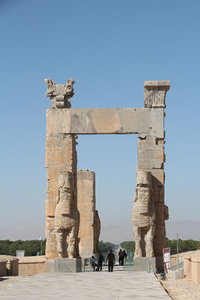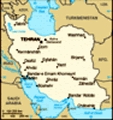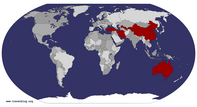Advertisement
Published: October 4th 2013

 Persepolis
Persepolis
The Gate of Many Nations - the main entrance to the Royal part of the city.Shiraz to Yazd
AHHHHHHHHHHHHHHHH! When are guides and driver, or guide/drivers in Asia and the Middle East going to understand – when you say stop I would like to take a photo, you mean now not 2 bloody km down the road. Also when you say next time we see X can you stop as I would like to take a photo – you don’t get the photo. Why? Cos the driver is in the middle of the road overtaking two trucks, a bus and couple of cars. The only reason that you can see for overtaking was because they were there in front of us. AHHHHHHHHHHHHH! OK Ro, I’ll take a deep breath - INNNNNN and whooooooooooosh! OK I’m over it, got it off my chest.
Thursday 3
rd October:
An early start this morning as we had another long drive with a number of places to see on the way. Despite the early start we still didn’t get into Yazd until 19:30. The places we stopped at were: Persepolis; the Archaemenian Necropolis at Naghsh-e Rostam; Bas-reliefs at Naghsh-e Rabat (an extra not on the itinerary but we were in the neighbourhood); Pasargadae; and

 Persepolis
Persepolis
Looking across the site towards the Apandana Palace (under awning). The column bases in foreground are some of the 250 that are the remnants of the Treasury.a late stop in a small town Abakuh. Due to a shortage of time we didn’t get to do a side trip that was on the itinerary – Zeinodin Caravanserai. This was always a do if time permitted, as it was a 120 km round side trip. I took the visit t0 Naghsh-e Rabat as a replacement.
Persepolis – what can I say but awe inspiring. I won’t go into details but it was well worth the visit. The city built by Darius – very Zoroastrian. The Archaemenids, as with subsequent dynasties up till the Arab invasion and the introduction of Islam were all Zoroastrians. Due to concerns about preservation many of the sites that you used to be able to enter have been closed to public access and are viewed from viewing platforms, of from the outside. Access to the very important staircase to the Apandana Palace is still possible with timber overlaid steps. The preservation work is quite good. Generally what was being visited was the ruins of the capital of the first World Empire – one which existed when the Greeks were just starting to come out of their shell and when the Romans were in

 Naghsh-e Rostam
Naghsh-e Rostam
The Achaemenian Necropolis tombs of (l to r): Darius II and Artaxerxes I.the distant future. The Persian Archaemenid Empire stretched from the Hindu Kush in the east as well as modern Pakistan, west to the Mediterranean sea, the Aegean, including Turkey and down into Egypt and North Africa and Nubia/Ethiopia. The Empire lasted until the Arrival of Alexander the Greats Macedonian Army. It is worth reporting that after Alexander looted the Royal Treasury it is reputed that 3,000 camels were required to cart the takings away. In one stroke Alexander got enough gold etc to keep his army paid and supplied for probably a hundred years. All that is left of the treasury is the bases of 250 columns.
Nest we went to the Necropolis. This is about 7 km from Persepolis and consists of four tombs cut into the rock cliffs, with associated bas-relief images for each. There are also a number of other relief images on the site. The tombs are those of: left to right if looking at the cliff – Darius II; Artaxerxes I; Darius I; and Xerxes I. In total there are seven bas-relief depicting royal ceremonials and Imperil conquest. There is also a structure not built into or on the cliff. This is the Ban

 Naghsh-e Rabat
Naghsh-e Rabat
The left hand image - Shapur I on his horse followed by his entourage on foot. Note the defaced figures and damage to horse.Khank (Central House) which has late Sassanian inscriptions on the walls celebrating various victories. The building is set in a hole excavated into the rock.
The second location (the extra visit) consists of a recess in a cliff about 5 m x 8 m. There is a rock towards the right hand side. The rock has a small overhang under which the Iranian tourism office has set 2 concrete bench seats. So, the reliefs can be observed in comfort – shaded and cool and sitting down. The reliefs are Sassanian with various scenes dating to the reigns of Ardashir 1 and Shapur the Great. The two dealing with Shapur have been defaced in antiquity with the faces of both men and animals chiseled off. By whom is anyone guess. It was suggested that it may have been the Arabs, but they would have defaced all three. Who, knows maybe it was done by a rival or successor.
Onward to Pasargadae. Disappointing and probably not worth the visit. Not much is left. The only monument of note and which I would have come to see anyway is the Tomb of Cyrus the Great. There are a couple of interesting

 Pasargadae
Pasargadae
Cyrus the Greats empty tomb on the open plain near Pasargadae.points about the tomb that I would like to share. Alexander the Great, admired Cyrus and told his troops that the tomb was off limits and not to be touched. All the Cyrus’s regalia and treasure was left intact by the Macedonians. When Alexander moved on to continue his pursuit of the Persian King and his Army he had to return a few months later as there was a revolt among the Persian nobles who thought as Alexander wasn’t there! Anyway during the revolt the tomb was robbed, by whom no one knows. The family of priests who were responsible for looking after the place, whether involved in the robbery or not, found out what it meant to cross Alexander. Apparently it wasn’t pretty and jail was not an option.
The other point was that prior to 1846 most European (well all Europeans) believed that the tomb was that of Solomon’s mother. Not sure what the local’s opinion was, but may have been the same. This was post Arab invasion and a lot of knowledge had been lost or destroyed. Anyway in 1846 European scholars realized that the tomb and its location was described in the journals of historians

 On The Road
On The Road
Some of the locals out for a ride.and writers who accompanied Alexander on his Campaign to take over the Persian Empire. The description fitted the tomb perfectly, so from that year it has been known as Cyrus’s Tomb.
Then we were off on a long drive to Yazd. Won’t go into the details of trying to find Naghsh-e Rabat – but we went sailing past, eventually Emir stopped and asked for directions about 5 km down the road. Maybe I should have said something earlier but didn’t really want to embarrass him – I knew roughly where the site was and don’t know how he missed the sign and arrow (big green sign with white writing) to the place. Anyway we got there. Eventually.
On to Yazd. Al long drive, the first third being along the main Tehran-Shiraz Freeway. At a place called Abadeh (well about 15 km south of it) we turned off onto a road that headed across the desert. Hot and flat. Emir was also starting to feel tired from the long drive, so we made a number of stops to rest. Lunch was had on the side of the road: grapes I bought from a stall on the main road, some

 Yazd - Moshir Hotel
Yazd - Moshir Hotel
The unconventional welcoming committee at the Moshir Hotel. Check out the size of the guy on the right. The chap on the left is about 6 feet tall.dates and water melon the Emir had bought the evening before and water. Simple but it tied us over till Yazd. We made one stop on the Abadeh to Yazd Road – at Abarkuh. As with several places I have seen in Iran the spelling on road signs is not consistent: alternate spelling is Abarkooh. Quite an interesting Desert town – has a historical section, which we didn’t visit – it was late in the afternoon and the sun was getting low. Emir stopped to show me one thing: a Cyprus Tree. Got to be the biggest Cyprus tree I have seen. The tree is also very old – not sure of how old, but I don’t think it’s the 4000 years Emir thought it might be. I think he was guessing.
As I mentioned – a late arrival in Yazd. Emir dropped me at the hotel and headed off to his parents place. He lives in Tehran but comes from Yazd (did I already mention that?).
Now the hotel is very interesting. It’s called the Moshir-Al-Mamalek Hotel Garden. The building is about 250 years old and dates from the Gajar dynasty. Originally it was a “garden” built

 Yazd Old City
Yazd Old City
the tops of the ubiquitous wind towers. The towers form part of a very old evaporative cooling system.by the local Gajar Governor –Moshir-al-Mamalek. Now garden is an interesting term – in Persia it sort of means a Palace. Moshir as well as being Governor was also the most popular bloke around. In fact he and his ilk were and are the most popular guys in any city, province or country – Tax Collectors. The only problem with the place – well a few. First the rooms are noisy as they were not built to be sound proof – music, kids, people dragging wheeled suitcases and consistent music (I think the same CD going round and round). It is very clean and comfortable – I’d say the best hotel I have been in in Iran. Oh yeah, how could I forget – the bloody cats. Place is crawling with them.
Mind you the welcome at the door was somewhat a little unconventional. Have a look at the pics.
Had dinner in the hotel – a buffet meal. A lot of Germans and southern Europeans in the hotel in the evening. The bloody Germans though! Recognize some of the Italians from other places we’ve stopped at on the trip.
Friday 4
th October:
Well

 Yazd
Yazd
The lower of the two Towers of Silence just outside the city. The towers were used Zoroastrians to inter the dead.today I finally did it. Bit the bullet and did something I have been thinking about and tempted to do for about a week. Bought myself a Persian Carpet, well OK I’ll tell the truth – two. Got a good deal. Cost me an arm and two legs (at least I have the other arm). Made a dent in the funds. Still have more than enough.
Today I had a new guide for the day. Majid, a friend of Emirs. I met him a few days ago, he was travelling more or less the same route as us with a Spanish couple. The reason for the change was that last night when he got home Emir found that an uncle had died that day. Being Muslim they get the body into the ground pretty quick so Emir was off attending the funeral. Majid did a great stand in job. Mind you his driving is a bit more sedate that Emir, but then again that could have been cos there wasn’t much traffic – Friday – prayer day.
We did the tourist sites in Yazd. First up we went to two Zoroastrian places. The first was an active Fire

 Yazd
Yazd
Looking down from the Tower of Silence to the building used by the families of the deceased.Temple, which is not very old – about eight years. The fire inside however is reputed have been burning for 1500 years. Majid gave an interesting and informative presentation of Zoroastrianism, and also discussed the place of the religion in Iranian society. Apparently they can drink wine – as long as they make it themselves and don’t give any to Muslims. The same is the case for Christians. After the Temple we went to a most interesting place: the Towers of Silence.
So what is a Tower of Silence – well a charnel house in reality? It is the place where historically in Iran Zoroastrians placed their dead. There are two towers in Yazd which has about 5,000 Zoroastrians (about 1/5 the of the total Zoroastrian population of Iran). Neither of the Towers are used any more, but similar towers are still in use in India. The process of interring the dead was that the family bought the deceased to the area of the Towers. At the base of the hills (the towers are built on the highest ground around) are a number of structures with a floor plan based on a cross. There are four rooms off the

 Yazd - Old City
Yazd - Old City
One of the many covered roadways in the old city. The roofs make for a cool street during the summer temps of up to 50 degrees Celsius.two halls forming the cross, one being a kitchen. The other rooms are for sleeping, eating etc. Apparently the body which was wrapped was placed in the centre of the cross overnight. The next day the body was carried by the family up the hill to a door in the tower. The body was handed over to the attendants and the family left – no one but the attendants were allowed in the tower.
The tower consists of a circular structure without a roof. The walls are about 5 metres high. The floor plan is based on a number of rings: outer ring which is the largest was for the bodies of men, the next in (slightly small) for women and the Inner ring for children. In the centre is a pit about 4 to 5 metres in diameter and about 1.5 metres deep. What happened/happens is that the bodies are laid out in the appropriate ring and left in the open. Vultures were encouraged to frequent the place. After a few weeks when the bones had been defleshed they were disposed of in the pit. After a number of years in the open these eventually broke down. The practice is outlawed in Iran now – the last Shah decided that the practice was Un-modern Iran. A new cemetery for the Zoroastrians has been built nearby. Whether by design or by accident one advantage of the system was that the water in the vicinity was not contaminated. Yazd relies on Qanats and wells for its water.
I won’t go into detail of all the sites visited, but want to share the Qanats with you. These and wind towers are truly amazing structures. Qanats are underground tunnels that are designed to bring water from the mountains to cities and villages. Some are over 1000, if not 2000 years old and are still in use. The system was quite ingenious. The max fall allowed is 5 degrees. When being constructed a line of wells are dug every 20 to 50 metres. These are then linked by a tunnel which feeds the water into the city or town. These tunnels, or Qanats, feed underground reservoirs, and individual houses. Quite complicated process, but fantastic engineering. The longest Qanat is 60 km long. The tunnels and reservoirs etc are inspected and repaired every year.
The other structure, which are associated with the Qanats are the Wind Towers. In reality an evaporative cooling system. The design is ingenious and quite a few hundred years old. Hey these guys were air-conditioning their houses when our ancestors were still living in hovels. The tower is designed to catch the wind or breeze. Only needs a slight breeze to work. The design also means that one half of the inlets is in shade at all times. The towers vary in height and size but the principle is the same. The vents that are in the sun actually remove hot air – hot air rises causing a draught. The air sucked down the shaded side as it descends is cooled by the mud fins in the tower. Directly below the tower is a pool of water. Now the air rushes over the water – and hey presto cool air. As with evaporative cooling the interior and exterior temps can vary by 10 degrees Celsius. You see the towers, or Badgirs to use their name, all over the city. The tallest is at Dowlat abad Garden (palace) and is about (now don’t quote me) 30 metres tall. It is the tallest badgir in Yazd, the tallest in Iran and since the structures are used nowhere else if so facto – the world.
Well that’s it for Yazd – tomorrow e head for Esfahan, another long drive. Going to see if we can stop in a couple of the villages on the way. Recommended to me as worth looking at. Tomorrow will tell.
Advertisement
Tot: 0.066s; Tpl: 0.012s; cc: 13; qc: 27; dbt: 0.0274s; 1; m:domysql w:travelblog (10.17.0.13); sld: 1;
; mem: 1.1mb









